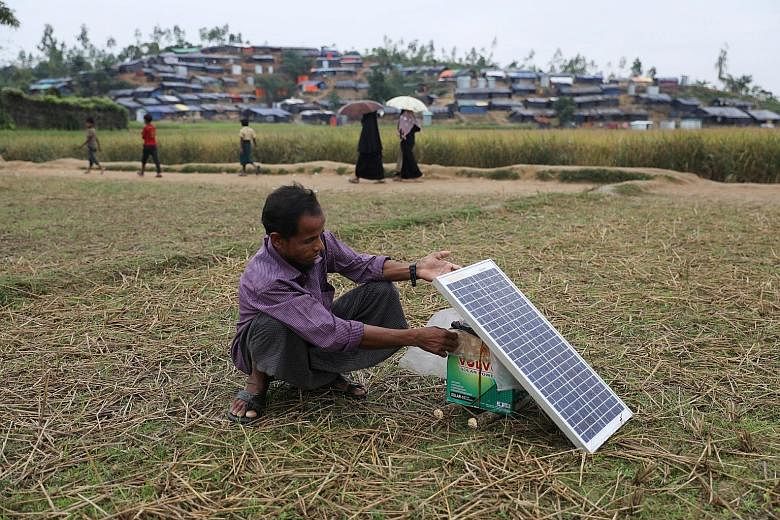UKHIYA (Bangladesh) • When Rohingya refugees began arriving in Bangladesh, after violence erupted in Myanmar's northern Rakhine state in August, local residents were puzzled to see some toting small solar panels on their shoulders.
Mr Main Uddin, a government official in charge of the Ukhiya sub-district during the Rohingya exodus, said the panels were being carried in despite the sound of gunfire on the border and reports of landmines.
More than 600,000 Rohingya Muslims have fled to Bangladesh since the Myanmar army launched a crackdown following attacks by Rohingya rebels on police posts and an army base.
Many refugees reported making an arduous trek lasting between five and 15 days along hilly and waterlogged roads - but the hazardous journey did not prevent them from carrying a solar panel as part of their luggage.
"This solar panel saved my life," said Mr Ayatullah, 18, who worked as a shopkeeper in Myanmar's Maungdaw township and is now at the Thaingkhali refugee camp.
He used his mobile phone to get information on safe routes to take while fleeing Myanmar, and his solar panel helped charge his phone. Besides the solar panel, he brought only some clothing, he said.
Interviews by the Thomson Reuters Foundation with more than 50 Rohingya refugees in Balukhali and Thaingkhali camps in Ukhiya, and observations of refugee households in the camps, suggest that large numbers of refugee families brought solar panels with them.
Refugees said they used the panels - each the size of a laptop and fitted with a battery and a small light - to charge mobile phones and provide light at night on the jungle roads on their way to Bangladesh.
Many also said they believed the panels would also come in useful if they had to live on the streets.
Mr Mohammad Yaser said solar panels were cheaper in Myanmar than in Bangladesh, with a 20-watt panel costing 20,000 kyat (S$20).
In Bangladesh, an equivalent panel costs 8 to 12 times as much.
"We had to stay on the streets for the first few days. We powered lights with a solar panel during that time and the light made us feel safe," said Mr Abdur Jaher, 45, who fled Maungdaw township with his wife and their five children.
There is no grid electricity connection at the camps. Refugees use solar panels, candles and kerosene lamps for light at night.
The Bangladeshi government has provided 500 solar-powered street lights and 2,000 home-system solar panels for the camps.
Solar power is also used for water purification systems.
THOMSON REUTERS

